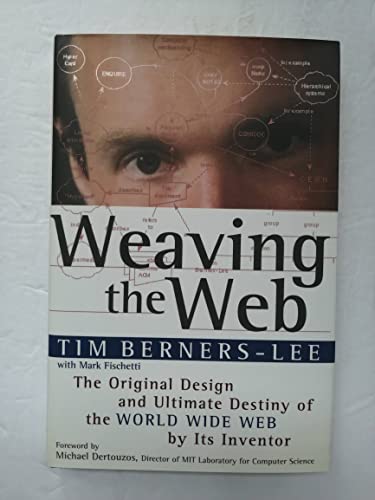Weaving the Web: The Original Design and Ultimate Destiny of the World Wide Web by Its Inventor
Berners-Lee, Tim
About the Book
Description:
May have limited writing in cover pages. Pages are unmarked. ~ ThriftBooks: Read More, Spend Less 1.15. Seller Inventory # G0062515861I4N00
About this title:
Synopsis:
Tim Berners-Lee, the inventor of the World Wide Web, has been hailed by Time magazine as one of the 100 greatest minds of this century. His creation has already changed the way people do business, entertain themselves, exchange ideas, and socialize with one another. With new online businesses and communities forming every day, the full impact of Berners-Lee's grand scheme has yet to be fully known.
Berners-Lee's creation was fueled by a highly personal vision of the Web as a powerful force for social change and individual creativity. He has never profited personally from the Web but has devoted himself to its continued growth and health. Now, this low-profile genius tells his own story of the Web's origins-from its revolutionary introduction and the creation of the now ubiquitous WWW and HTTP acronyms to how he sees the future development of this revolutionary medium. Today, Berners-Lee continues to facilitate the Web's growth and development as director of the World Wide Web Consortium and from his position at the MIT Laboratory for Computer Science.
Berners-Lee offers insights to help readers understand the true nature of the Web, enabling them to use it to their fullest advantage. He shares his views on such critical issues as censorship, privacy, the increasing power of software companies in the online world, and the need to find the ideal balance between the commercial and social forces on the Web. His incisive criticism of the Web's current state makes clear that there is still much work to be done. Finally, Berners-Lee presents his own plan for the Web's future, one that calls for the active support and participation of programmers, computer manufacturers, and social organizations to make it happen.
His vision of the Web is something much more than a tool for research or communication; it is a new way of thinking and a means to greater freedom and social growth than ever before possible.
Review: If you can read this review (and voice your opinion about his book on Amazon.com), you have Tim Berners-Lee to thank. When you've read his no-nonsense account of how he invented the World Wide Web, you'll want to thank him again, for the sheer coolness of his ideas. One day in 1980, Berners-Lee, an Oxford-trained computer consultant, got a random thought: "Suppose all the information stored on computers everywhere were linked?" So he created a system to give every "page" on a computer a standard address (now called a URL, or Universal Resource Locator), accessible via the HyperText Transfer Protocol (HTTP), formatted with the HyperText Markup Language (HTML), and visible with the first browser, which did the trick of linking us all up.
He may be the most self-effacing genius of the computer age, and his egalitarian mind is evident in the names he rejected for his invention: "I thought of Mine of Information, or MOI, but moi in French means 'me,' and that was too egocentric.... The Information Mine (TIM) was even more egocentric!" Also, a mine is a passive repository; the Web is something that grows inexorably from everyone's contributions. Berners-Lee fully credits the colorful characters who helped him get the bobsled of progress going--one colleague times his haircuts to match the solstices--but he's stubbornly independent-minded. His quest is to make the Web "a place where the whim of a human being and the reasoning of a machine coexist in an ideal, powerful mixture."
Hard-core tech types may wish Berners-Lee had gone into deeper detail about the road ahead: the "boon and threat" of XML, free vs. commercial software, VRML 3-D imaging, and such. But he wants everyone in on the debate, so he wrote a brisk book that virtually anyone can understand. --Tim Appelo
Bibliographic Details
Title: Weaving the Web: The Original Design and ...
Publisher: HarperOne
Publication Date: 1999
Binding: Hardcover
Condition: Very Good
Dust Jacket Condition: No Jacket
